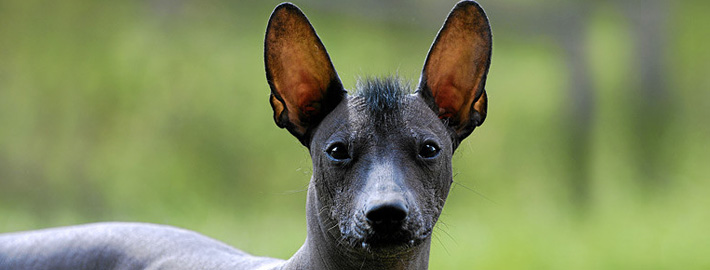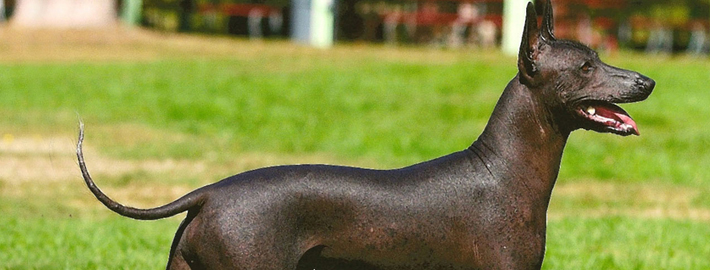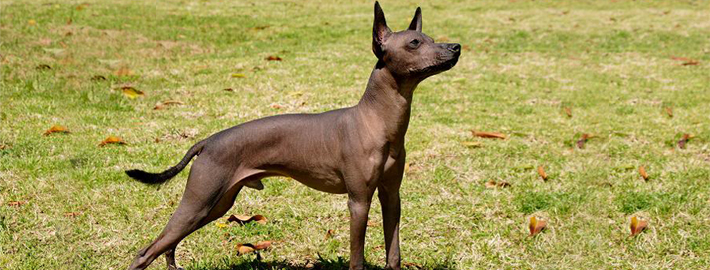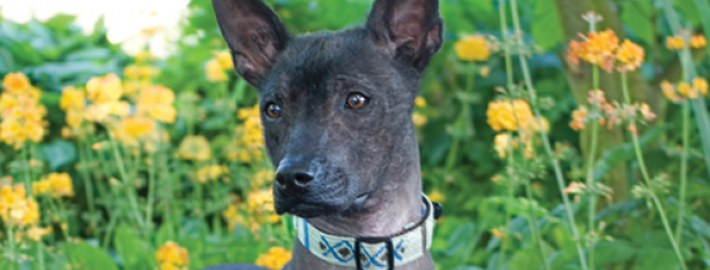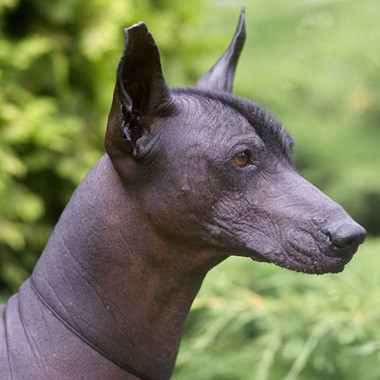What makes the Xoloitzcuintli Unique?
More commonly known as the Mexican Hairless dogs, Xoloitzcuintli naturally stand out in a world filled with fur covered canines. Members of this breed make good therapy dogs and they also excel at various forms of dog sports. However, these rare creatures can easily sell for $2,000 or more dollars, so acquiring one as a pet is probably not within everyone’s means.
Page Contents
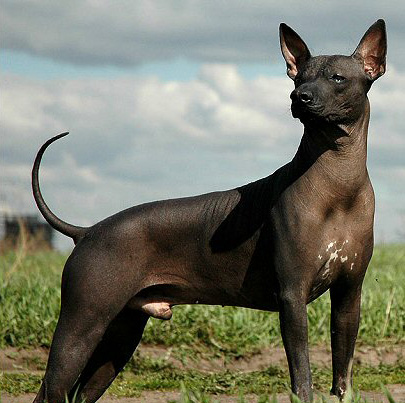
SnapShot
| Size: | Males – 46 to 58 cm (18 to 23 inches) Females – 46 to 58 cm (18 to 23 inches) |
| Weight: | Males – 5 to 23 kg (10 to 50 pounds) Females – 5 to 23 kg (10 to 50 pounds) |
| Origin: | North America,Mexico, Central America |
| Life Span: | 14 – 20 Years |
| Colour: | Black, Gray, Light Brown, Merle, Slate, Red |
| Litter Size: | up to 10 puppies |
Is the Xoloitzcuintli Right For You?
Mexican Hairless dogs are very cuddly as far as members of their families’ are concerned. These loyal canines have a habit of becoming attached to the person that they spend the most time around. Therefore, everyone in the household should be involved in taking care of these dogs so that the animal in question gets along well with everyone. However, members of this breed typically remain aloof around strangers and may even become aggressive towards them if the dogs have not been properly trained.
In 5 Words
- Affectionate
- Intelligent
- Playful
- Sensitive
- Snuggly
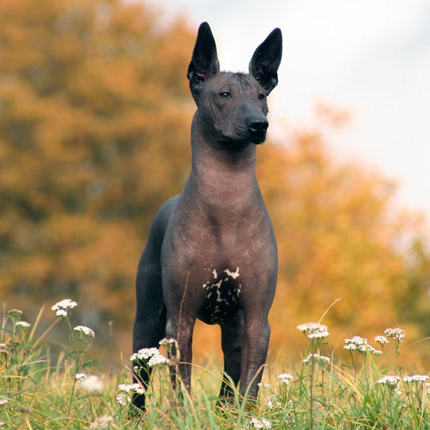
Characteristics
Learn About the Xoloitzcuintli
Description
General Description
Despite their ancient origins, Mexican Hairless dogs look a lot like Manchester Terriers. However, the otherwise unusual appearance of Xoloitzcuintli dogs is mostly likely due to a random gene mutation that occurred in the distant past. After all, these dogs evolved on their own throughout the course of history instead of being selectively breed by human beings in order to encourage specific traits. Even so, the hairless dogs look almost exactly like their coated counterparts.
Size
Mexican Hairless dogs are available in toy, miniature, and standard sizes. Toy dogs tend to stand between 10 and 14 inches (25.4 and 35.5 centimeters) tall. Miniatures typically stand somewhere between 14 and 18 inches (35.5 and 45.7 centimeters) high. Dogs that fall between 18 and 23 inches (45.7 and 58.4 centimeters) in height are considered to be of the standard size. Dogs of varying height ranges are often born in the same litter. However, all Xoloitzcuintles should weigh between 10 and 50 pounds (4.5 and 22.6 kilograms).
Coat
Hairless dogs only have a small amount of fur on their tails and heads. The other members of this breed have short, glossy fur. Xoloitzcuintles come in a wide range of colors. However, typical hues for this breed include red, black, bronze, liver, slate, and greyish black. White markings and spots are also commonly seen on these dogs.
The precursors to the Xoloitzcuintle breed accompanied their owners across the Bering Strait from Asia into what is now North America. These canines were named for the Aztec god of fire, Xolotl, as well as for their species. After all, the suffix “itzcuintli” simply means “dog”. Members of this breed were even thought to possess healing powers, a belief that initially led to their use as therapy dogs. Xoloitzcuintli were also thought to guide the dead on their way to the next world. Of course, this didn’t stop the native people from occasionally eating the dogs when they got hungry.
Mexican Hairless dogs were officially recognized by the American Kennel Club (AKC) in 1887, but people’s interest in the dogs waned shortly thereafter. The breed did experience another short burst of popularity during the 1940s, when one of their number won an AKC Championship title. About twenty years later, Xoloitzcuintli were once again nearly forgotten and they were removed from the American Kennel Club’s breed registry in 1959. As is the case with many breeds that were on the verge of extinction, fans brought the dogs back to the forefront of history. The breed was readmitted to the American Kennel Club in 2011.
Mexican Hairless dogs are known for their calm dispositions. They are also a very cuddly breed as far as members of their families’ are concerned. These loyal canines have a habit of becoming attached to the person that they spend the most time around. Therefore, everyone in the household should be involved in taking care of these dogs so that the animal in question gets along well with everyone. Members of this intelligent breed have good hearing and are quick to sound the alarm when unfamiliar people or animals enter their domains but they are not nuisance barkers. However, members of this breed typically remain aloof around strangers and may even become aggressive towards them if the dogs have not been properly trained.
Caring for Your Xoloitzcuintli
General Health
Given plenty of exercise and a quality diet, these healthy dogs can easily live anywhere from 12 to 15 years. Xoloitzcuintles need a great deal of care during their lifetimes, a fact which makes them an unsuitable choice for first time pet owners. Members of this breed have to be protected from the sun in the summer and from the cold in the winter. When they go outdoors, these dogs will either need to be covered with sunscreen or a sweater depending on the season. Once inside their homes, these canines don’t need any sort of skin protection. In fact, keeping them consistently covered up can also cause skin problems for Xoloitzcuintles. Prospective owners should additionally be aware that hairless members of this breed generally are missing their premolars. However, this doesn’t seem to affect the dog in any way and the missing teeth are not considered a flaw in the show ring. Of course, anyone that want to purchase a puppy should always be sure that they are getting their new pet from a responsible breeder.
Care
Daily
Members of this breed are quite athletic and will need daily exercise sessions.
Weekly
Brushing their teeth several times a week is crucial to your pet’s wellbeing. Xoloitzcuintli will also have to have their toenails trimmed and their feet cleaned on a weekly basis. Regularly checking pets for any other health issues is similarly useful because doing so allows owners to spot potential ailments before they become problematic.
Monthly
To keep pets from falling victim to avoidable illnesses, owners should give their dogs’ parasite prevention medicine at least once a month.
Grooming & Bathing
Mexican Hairless dogs are known to groom themselves in a cat-like fashion but it is still a good idea to give them a bath every few weeks or so using a mild, unscented shampoo. Rinsing them off from time to time can also help keep these dogs free of accumulated sweat, dirt, and other debris. However, owners will want to avoid using oils and lotions on members of this breed. Pet owners will also need to clean off any excess sunscreen that is on their pet’s skin after the animal in question returns indoors.
Exercise & Training
Xoloitzcuintli require proper socialization and obedience training from a young age. It is important for owners to establish their authority early to avoid problems from arising later on. However, members of this breed are highly trainable and are incredibly intelligent. Xoloitzcuintli puppies will also benefit from participating in playgroups with other dogs of a similar age. After all, members of this breed are particularly boisterous as puppies but they typically calm down when they get older.
As is the case with most dogs, Xoloitzcuintli benefit from positive reinforcement and quick corrections when they have done something that they shouldn’t. House training is possible for members of this breed but, in order to keep hairless dogs from having to go outside during the winter, paper or crate training is more commonly recommended.
Owners can even train these dogs to safely walk off-leash because the Mexican Hairless is not likely to wander away from their human companions on outings. If they do, the dogs will generally return as soon as they are called.. However, the dogs should be closely supervised when they are playing outdoors because they like to climb high fences and can easily escape their environment if they are not carefully watched.

